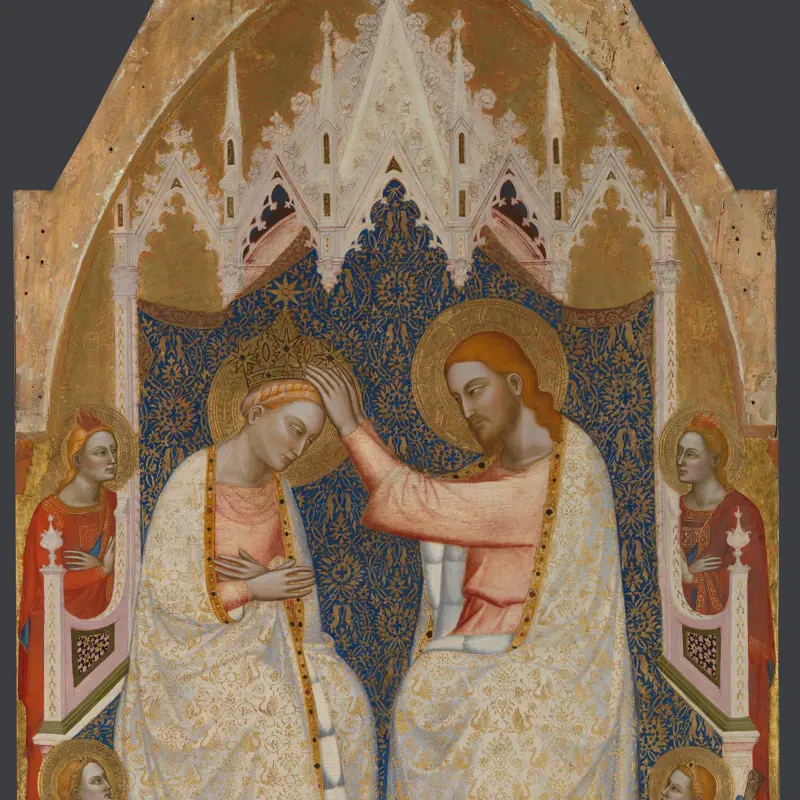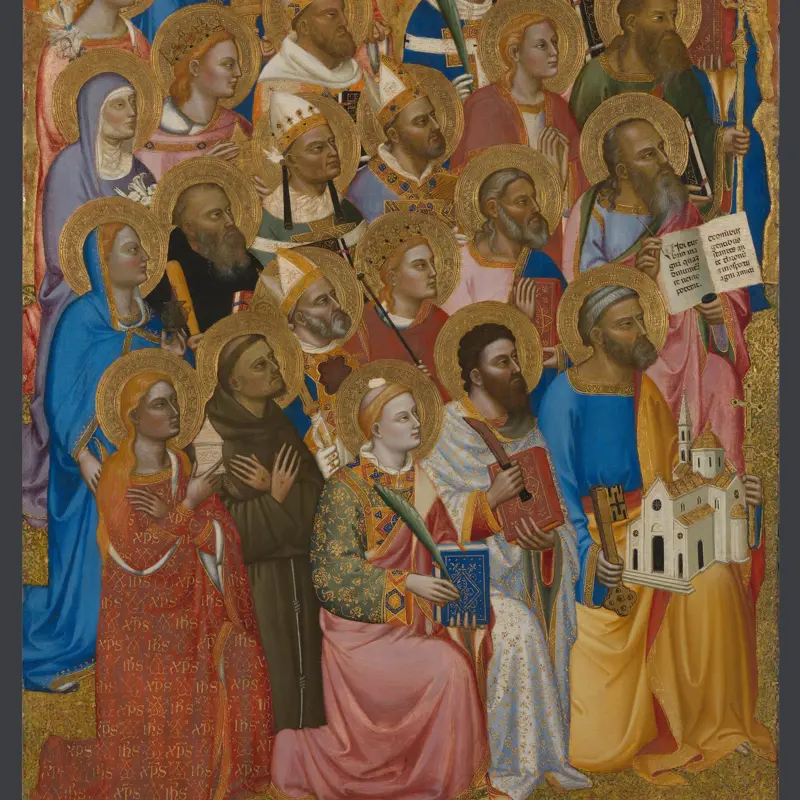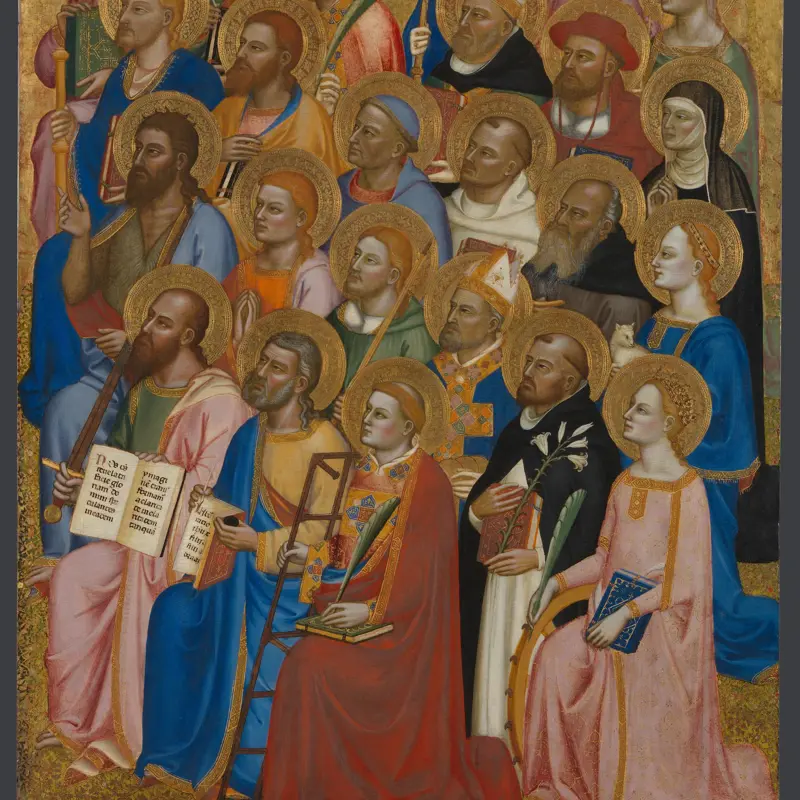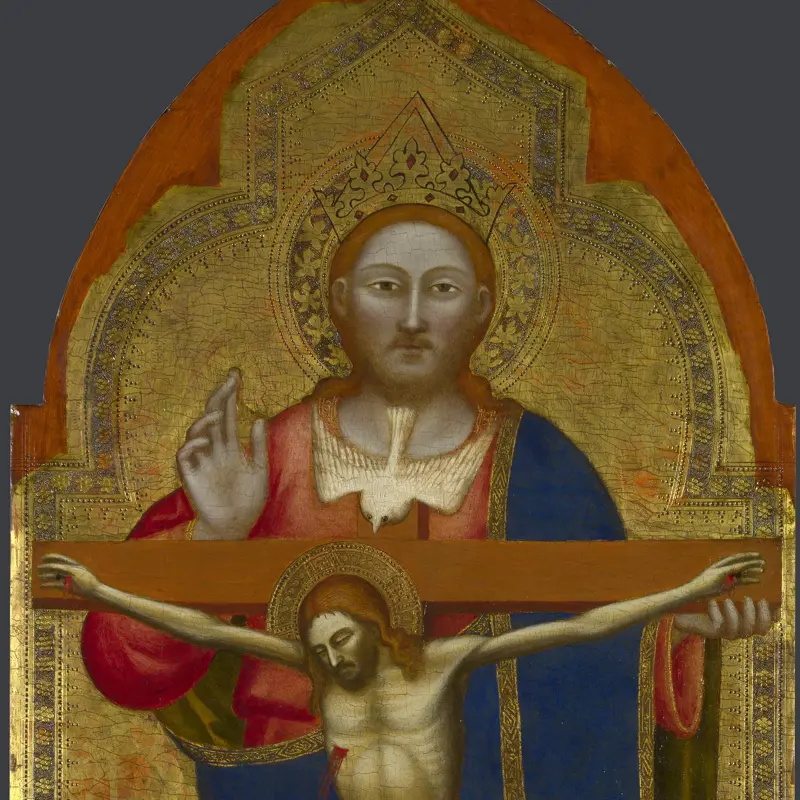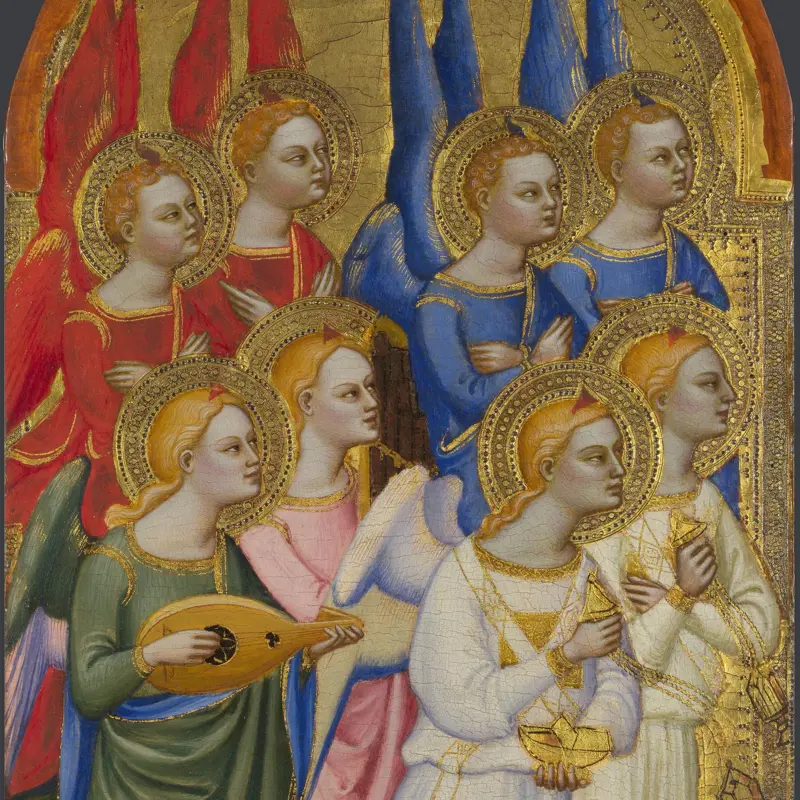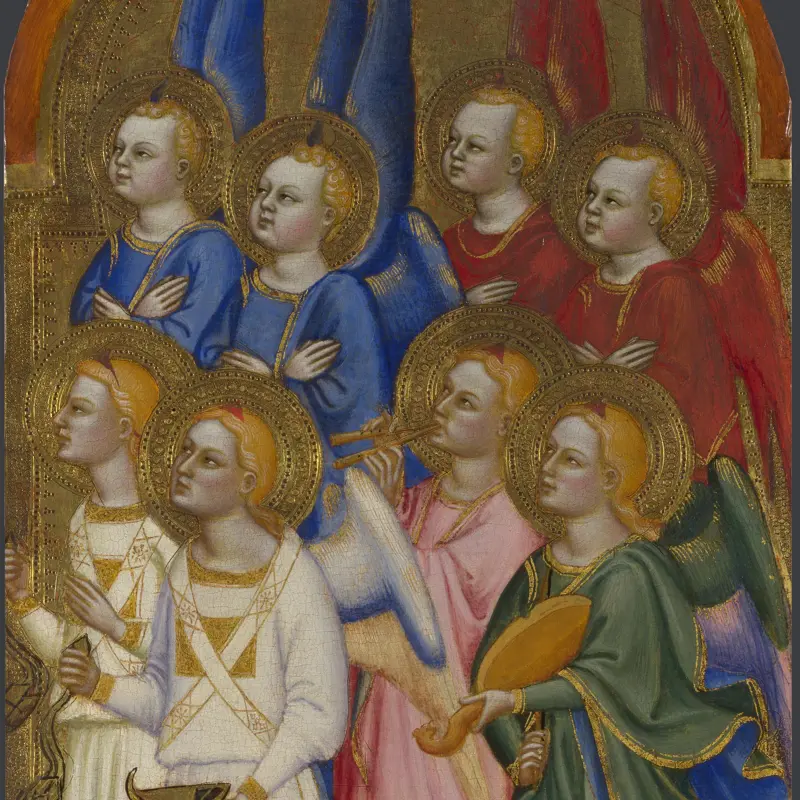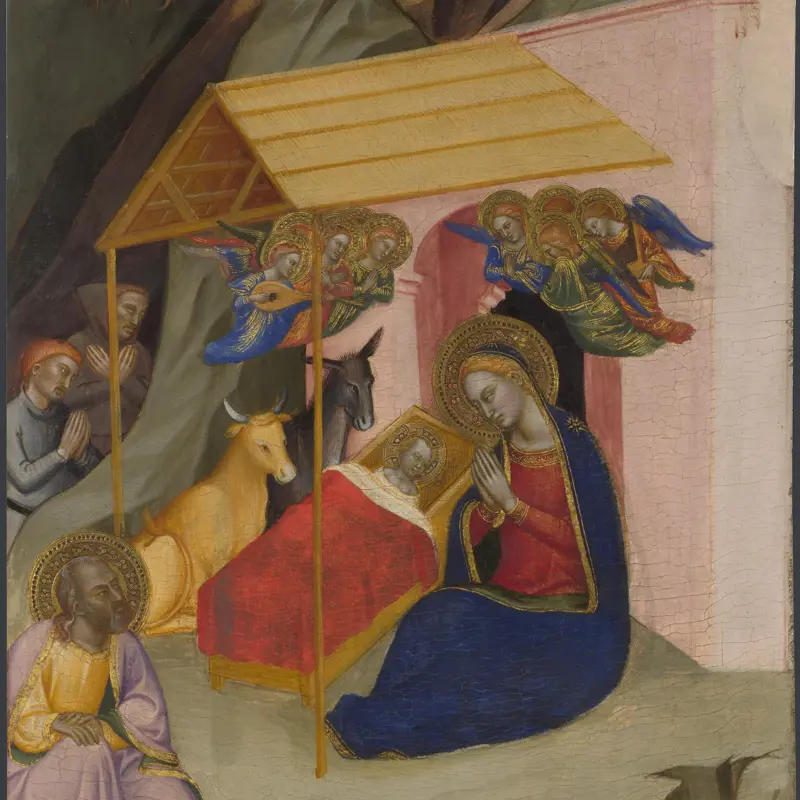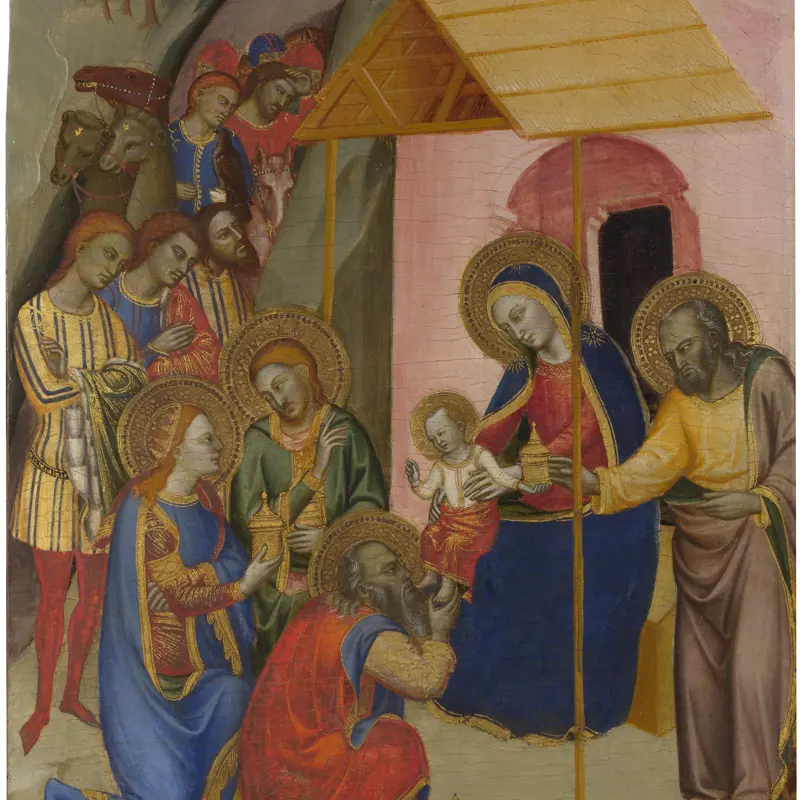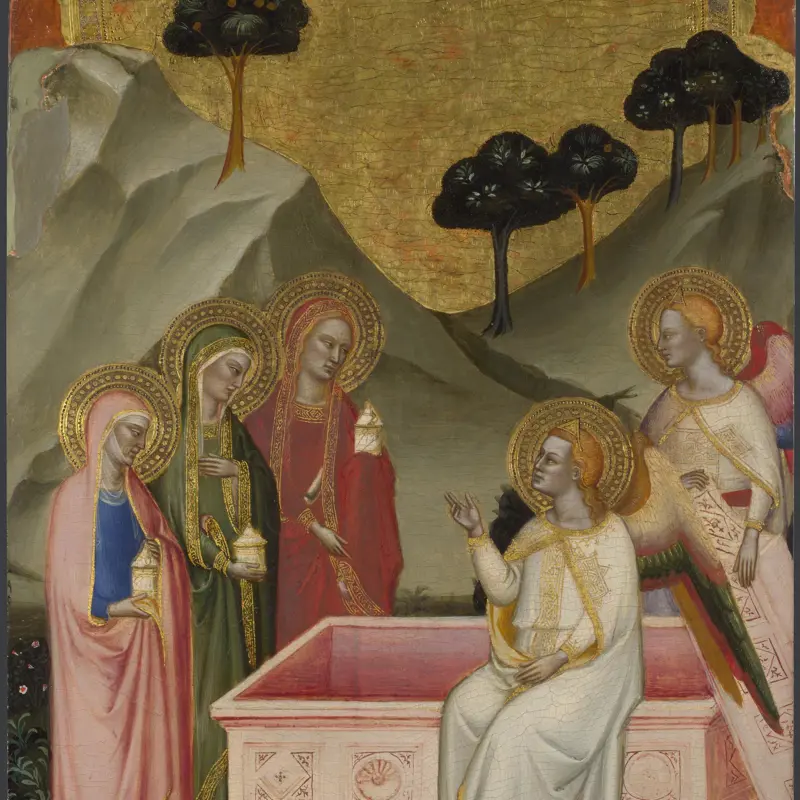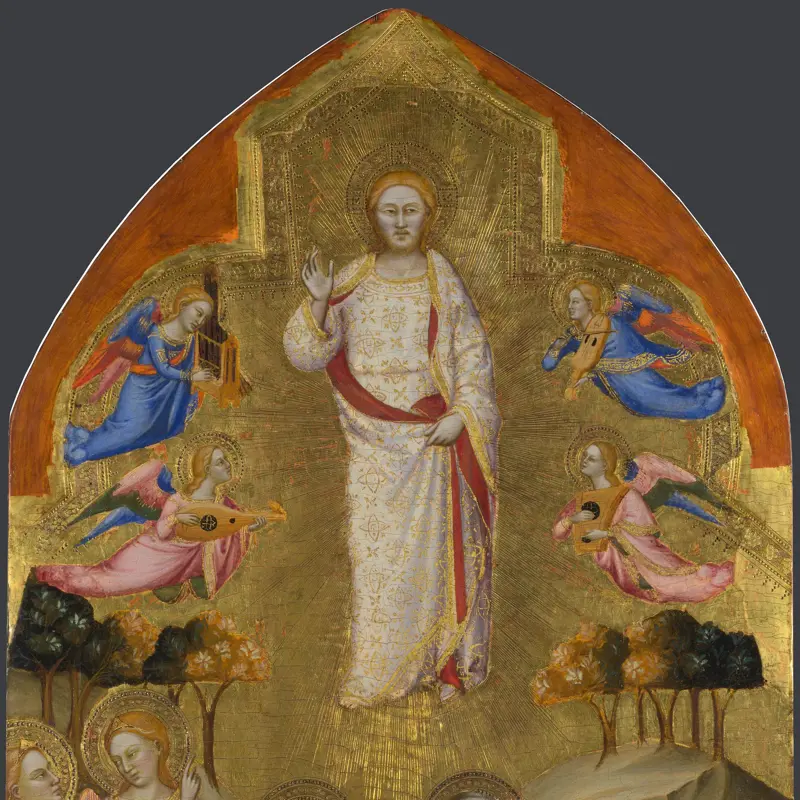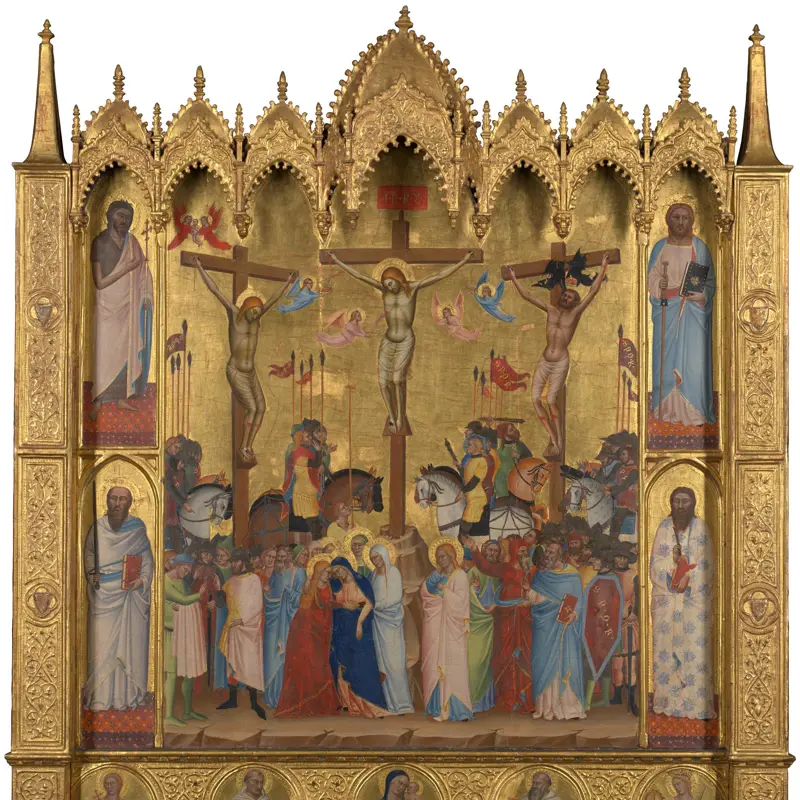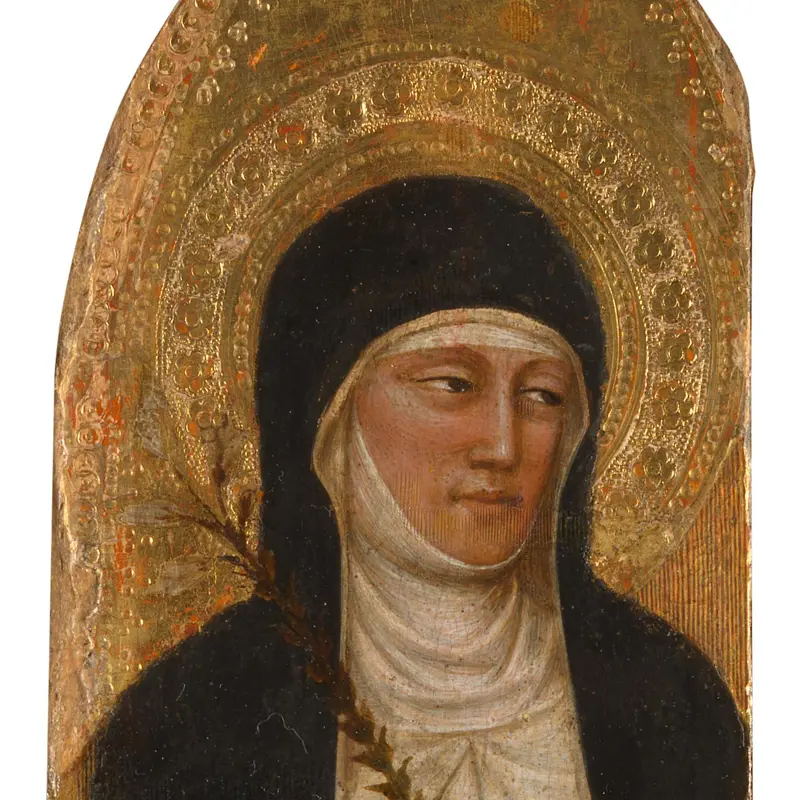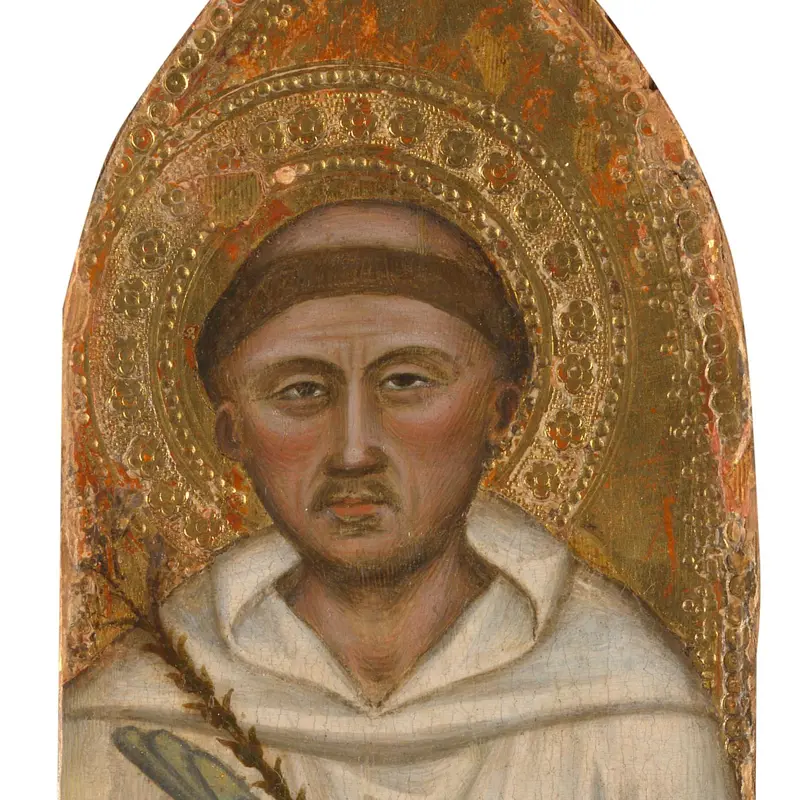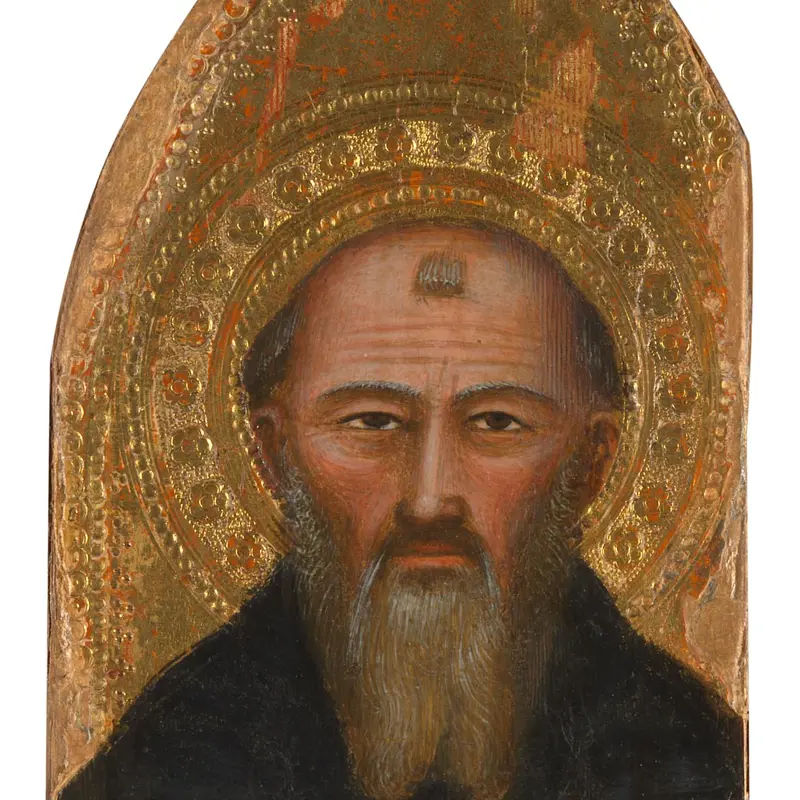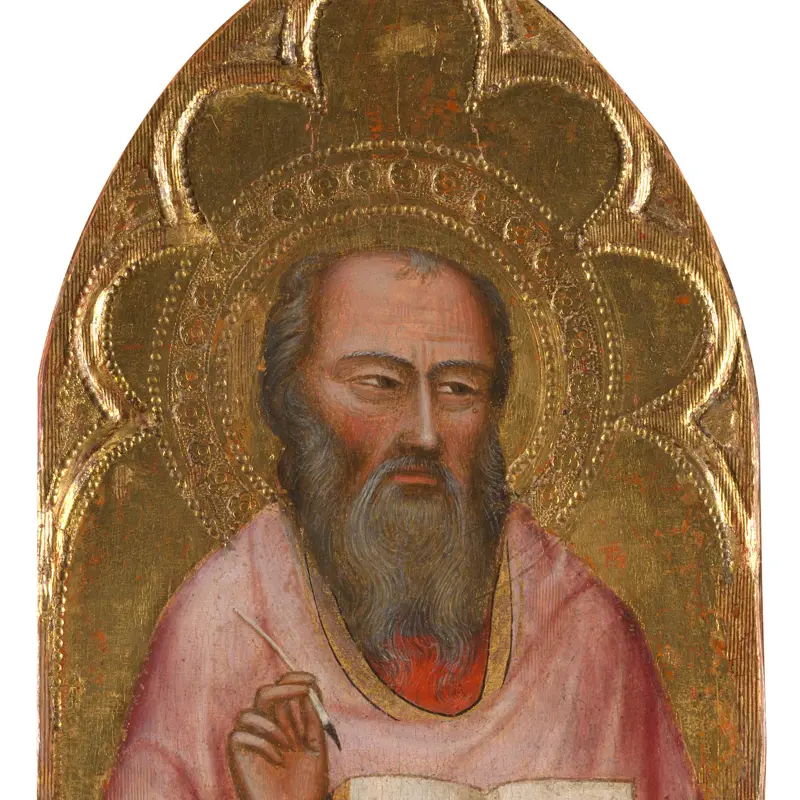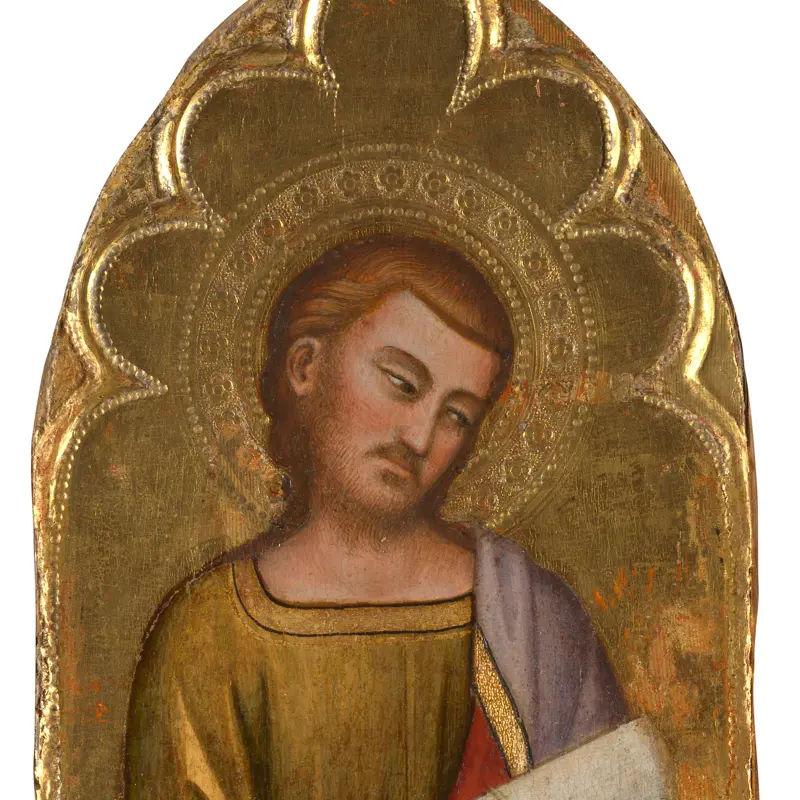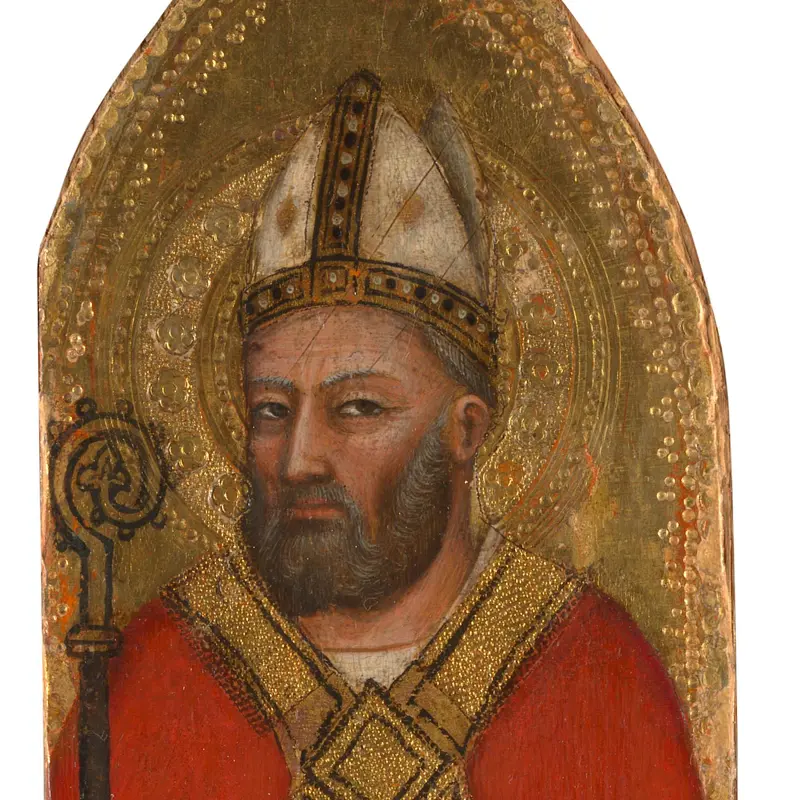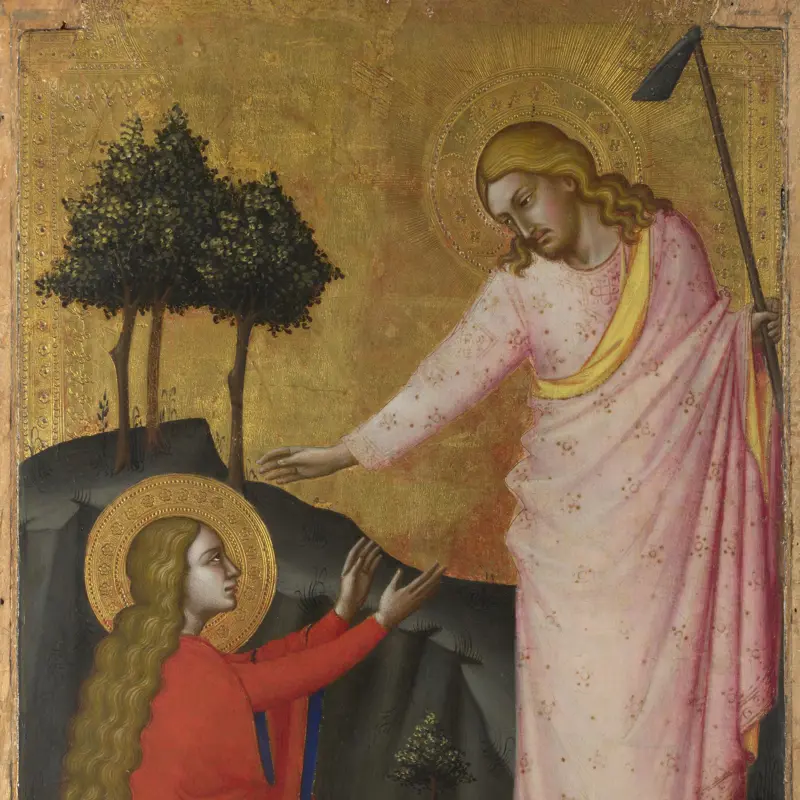Jacopo di Cione and workshop, 'The Coronation of the Virgin: Central Main Tier Panel', 1370-1
About the work
Overview
This is the central panel of a large altarpiece made for the church of San Pier Maggiore, Florence. Christ crowns the Virgin, after her body and soul have been taken up to heaven. This was an important moment: it established the Virgin’s role as an intercessor to whom believers could address their prayers. It is not recorded in the Bible but is described in the Golden Legend, a medieval compilation of saints' biographies.
The event’s glory and majesty are reflected here in the rich decoration of Christ and the Virgin’s white robes, with golden embroidery showing birds, hearts and flowers. Angels, dressed in colourful robes, play beautifully detailed musical instruments, encouraging viewers to imagine heavenly music accompanying the scene.
The Virgin’s coronation was a popular scene in Florence where artists based their composition upon Giotto’s altarpiece made for the Baroncelli chapel at Santa Croce around 1334.
Key facts
Details
- Full title
- The Coronation of the Virgin: Central Main Tier Panel
- Artist
- Jacopo di Cione and workshop
- Artist dates
- Documented 1365; died 1398 -1400
- Part of the series
- The San Pier Maggiore Altarpiece
- Date made
- 1370-1
- Medium and support
- Egg tempera on wood (probably poplar)
- Dimensions
- 206.5 × 113.5 cm
- Acquisition credit
- Bought, 1857
- Inventory number
- NG569.1
- Location
- Room 57
- Collection
- Main Collection
Provenance
Additional information
Text extracted from the ‘Provenance’ section of the catalogue entry in Dillian Gordon, ‘National Gallery Catalogues: The Italian Paintings before 1400’, London 2011; for further information, see the full catalogue entry.
Exhibition history
-
2015Visions of Paradise: Botticini's Palmieri AltarpieceThe National Gallery (London)4 November 2015 - 14 February 2016
Bibliography
-
1677F. Bocchi and G. Cinelli, Le bellezze della città di Fiorenza, dove a pieno di pittvra di scvltvra di sacri templi di palazzi, i piu notabili artifizj, e piu preziosi si contengono, Florence 1677
-
1754G. Richa, Notizie istoriche delle chiese fiorentine, 10 vols, Florence 1754
-
1878G. Vasari, Le vite de'più eccellenti pittori, scultori ed architettori: Con nuove annotazioni e commenti di Gaetano Milanesi, ed. G. Milanesi, 8 vols, Florence 1878
-
1887M.-F. Reiset, Une visite à la Galerie nationale de Londres, 2nd revised edn, Rapilly 1887
-
1901A. Venturi, Storia dell'arte italiana, 11 vols, Milan 1901
-
1908O. Sirén, Giottino und seine Stellung in der gleichzeitigen florentinischen Malerei, Leipzig 1908
-
1917O. Sirén, Giotto and Some of His Followers, Cambridge MA 1917
-
1923R. van Marle, The Development of the Italian Schools of Painting, 19 vols, The Hague 1923
-
1927R. Offner, Studies in Florentine Painting: The Fourteenth Century, New York 1927
-
1930R. Offner and K. Steinweg, A Critical and Historical Corpus of Florentine Painting, 8 vols, New York 1930
-
1951Davies, Martin, National Gallery Catalogues: The Earlier Italian Schools, London 1951
-
1982Centro d'Incontro della Certosa di Firenze, Iconografia di San Benedetto nella pittura della Toscana. Immagini e aspetti culturali fino al XVI secolo, Florence 1982
-
1986Davies, Martin, National Gallery Catalogues: The Earlier Italian Schools, revised edn, London 1986
-
1988Gordon, Dillian, National Gallery Catalogues: The Early Italian Schools before 1400, revised edn, London 1988
-
1989National Gallery, 'Pictures Cleaned and Restored in the Conservation Department of the National Gallery, January 1989 – October 1992', National Gallery Technical Bulletin, XIV, 1993, pp. 95-6
-
1989D. Bomford et al., Italian Painting before 1400 (exh. cat. The National Gallery, 29 November 1989 - 28 February 1990), London 1989
-
1991J. Dunkerton et al., Giotto to Dürer: Early Renaissance Painting in the National Gallery, New Haven 1991
-
1991M. Finch, 'Petrine Landmarks in Two Predella Panels by Jacopo di Cione', Artibus et historiae, XII/23, 1991, pp. 67-82
-
1992C. King, 'Medieval and Renaissance Matrons, Italian-Style', Zeitschrift für Kunstgeschichte, LV/3, 1992, pp. 372-93
-
1993R. White and J. Pilc, 'Analyses of Paint Media', National Gallery Technical Bulletin, XIV, 1993, pp. 86-94
-
1994E. Langmuir, The National Gallery Companion Guide, London 1994
-
1994E.S. Skaug, Punch Marks from Giotto to Fra Angelico: Attribution, Chronology and Workshop Relationships in Tuscan Panel Painting, With Particular Consideration to Florence c.1330-1430, Oslo 1994
-
1994A. Thomas, An Illustrated Dictionary of Narrative Painting, London 1994
-
1994D. Saunders and J. Kirby, 'Light-Induced Colour Changes in Red and Yellow Lake Pigments', National Gallery Technical Bulletin, XV, 1994, pp. 79-97
-
1995D. Norman, '"Hail most Saintly Lady": Change and Continuity in Marian Altarpieces', in D. Norman (ed.), Siena, Florence and Padua: Art, Society and Religion, 1280-1400, New Haven 1995, vol. 2, pp. 195-215
-
1996A.J. Hamber, A Higher Branch of Art: Photographing the Fine Arts in England, 1839-1880, Amsterdam 1996
-
2001
C. Baker and T. Henry, The National Gallery: Complete Illustrated Catalogue, London 2001
-
2011Gordon, Dillian, National Gallery Catalogues: The Italian Paintings before 1400, London 2011
About this record
If you know more about this work or have spotted an error, please contact us. Please note that exhibition histories are listed from 2009 onwards. Bibliographies may not be complete; more comprehensive information is available in the National Gallery Library.
Images
About the series: The San Pier Maggiore Altarpiece
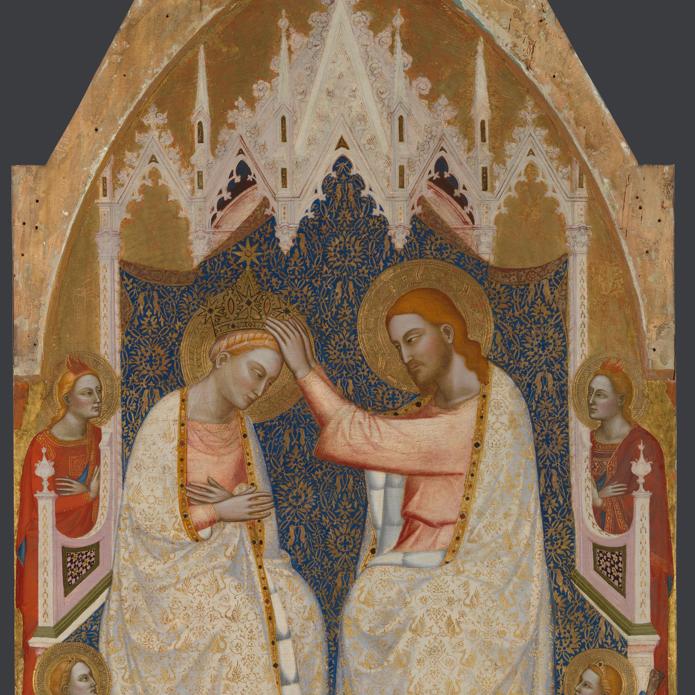
Overview
These images come from a large, four-tiered altarpiece created for the high altar of the choir of the church of San Pier Maggiore in Florence. It was made up of a number of separate panels, most of which are now in the National Gallery’s collection.
Although only the facade of the church remains today, it was one of the oldest and most important religious institutions in Florence when this altarpiece was made. It was founded by the first bishop of Florence, Saint Zenobius, in the fifth century. The picture formed the backdrop to one of the ceremonies relating to the ordination of each bishop of Florence until the late sixteenth century.
The altarpiece was most probably commissioned by the wealthy Florentine Albizzi family and many of its saints relate to their family or their trade as wool merchants. The central images showed the coronation of the Virgin by Christ surrounded by adoring saints – a highly popular image in Florence.

